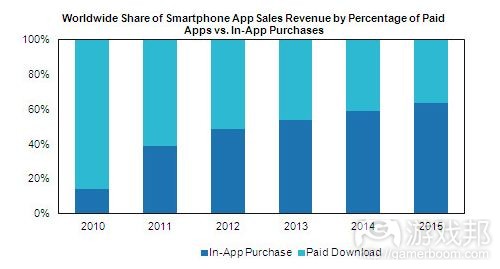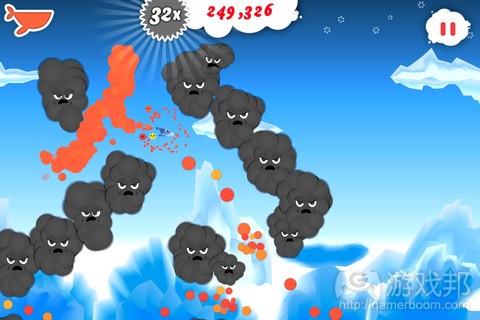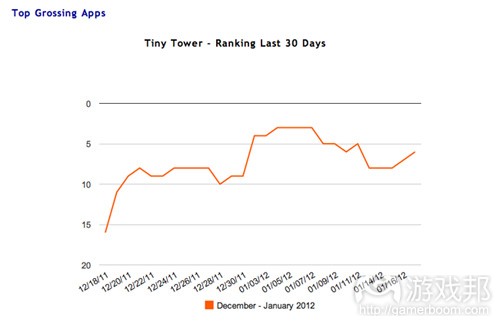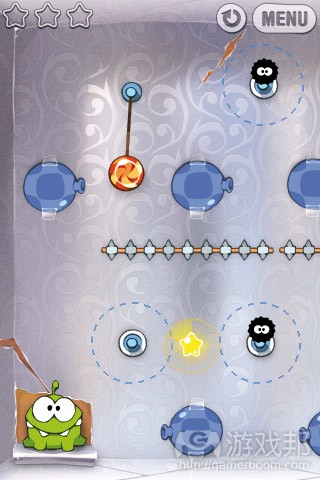每日观察:关注2015年IAP产值或达56亿美元(1.18)
1)市场分析公司IHS Screen Digest最近报告预测,IAP(应用内置付费功能)模式将在2015年创收56亿美元,约占整个手机应用市场收益的64%,比2011年的9.7亿美元增加5倍以上。
分析师Kack Ken称2011年用户下载的96%智能手机应用属于免费产品,2012年付费应用将难以抵御这种来自免费增值模式的竞争。
IHS Screen Digest称2011年第三季度在美国App Store排名前列的营收榜单中,免费应用占比45%,此类产品在Android Market营收榜单前列所占比例也达到31%。
目前来看,最抢手的IAP功能是虚拟货币,在2011年第三季度iPhone应用IAP销量中占比63%;其次是付费解琐特定游戏功能,在该平台IAP销量中占比22%;非游戏产品的IAP人气较低,付费购买额外媒体内容的IAP在美国市场仅占比2%,在英国的这一比例为0,而限时订阅模式的IAP销量目前在英国则占比5%。
2)市场调研公司Evans Data最近针对1200多名开发者的问卷调查结果表明,HTML5已经获得开发者的广泛支持,43%北美受访者已经在使用该平台开发产品,还有39%的欧洲、中东和非洲开发者也在使用这项技术。
值得注意的是,亚太地区有58%开发者已经在开发HTML5内容。从全世界范围来看,已经采用HTML5技术或者准备使用该技术的开发者所占比例达到四分之三。
Evans Data称这种现象表明HTML5现在的开发者支持率已经超过Flash和Silverlight。
3)Mendeley网站最近发布的一份手机应用研究论文指出,用户平均每天使用移动设备的时间将近1小时(具体为59.23分钟),但他们访问应用程序(游戏邦注:这里指打开和关闭应用的时间间隔)平均时间不足1分钟,即71.56秒。
该论文采用了AppSensor这个虚拟应用感测器作为研究工具,调查了4100多部Android设备的应用程序使用情况(Android设备支持AppSensor在背景运行,但苹果iPhone则限制这种运行方式),并发现用户平均每天在“未知名”应用类型中投入了36.37秒时间,用户在与自己的移动设备相关的应用、主题和工具中投入时间最长,而在游戏应用中投入时间将近一半,体验《愤怒的小鸟》、《Wordfeud FREE》和《Solitaire》平均时间达114.25秒(如下图)。
受访者一般从早上6点至7点开始访问应用程序,这段时间至下午1点均是用户访问应用程序的普遍起始时间。应用程序使用率在傍晚6点时达到高峰,在早上5点时则是最低峰状态。
不同应用每天的使用高峰期也存在差异,例如社交应用的活跃使用期是晚上9点至凌晨1点,而用户一整天都会使用的是信息沟通应用,此类应用使用率只有在凌晨时间才会达到最低点。
该论文还指出,应用程序使用情况存在一个链式反应,即使用某款应用的用户,也很可能接纳另一款类似的应用。例如某用户开启AroundMe(生活服务应用)之后,还会继续开启Find A Starbucks(购物应用),Google Maps(旅行应用),将近半数的链式反应来自“信息沟通”类应用。
4)英国手机游戏工作室ustwo最近称他们对《Whale Trail》付费版游戏在iOS平台的运营表现感到失望(付费下载量为14万次),因此决定放弃付费模式,转向免费增值模式。
据其所称,他们两个月前在iOS平台发布游戏,投入大笔制作和营销成本以期让游戏晋升榜单前列,虽然目前每天仍有500-700次的iOS下载量,但他们还是觉得这一结果并不如意,后来向Android Market发布售价99美分的付费版本则再次证明了这种付费模式的失败。
该游戏在iOS和Android两个平台的制作、营销和维护成本至今已达25万英磅,虽然投资回报率很不乐观,但他们并不打算取消游戏售价,而是称这将是公司最后一款付费游戏,今后将开发免费游戏。
5)NimbleBit联合创始人Ian Marsh最近表示,自《Tiny Tower》进入iTunes年度最佳iPhone游戏榜单后,该游戏每天新增DAU超过1.6万,目前DAU总数超过100万。
该游戏的活跃用户转化率也非常惊人,在上月有将近50%的用户下载游戏之后成了活跃用户。据AppData观察,该游戏自入选苹果iPhone年度最佳游戏之后就从未跌落iPhone热门和营收榜单前10名。该公司不久前曾表示,游戏的付费用户转化率将近5%,平均每名用户为游戏创收10美元。
6)俄罗斯开发商ZeptoLab首席执行官Misha Lyalin最近表示,《割绳子》免费及付费版本下载量已达8500万次,其中付费版下载量超过2000万次。
他同时还指出,ZeptoLab并不是因为看好黑莓PlayBook,而是为了满足黑莓用户的需求,才推出了这款游戏的黑莓版本,并称未来还将发布Windows Phone和Symbian版本。
7)零售分析公司Zmags最近发布的智能手机及平板电脑用户的信息图表显示,Zmags目标用户中有52%连网设备用户属于40多岁的中年女性,家庭平均年收入为6.3万美元,43%拥有智能手机,16拥有平板电脑。
从所有用户群体的情况来看,87%用户更喜欢通过网站和移动网络购物,仅有4%喜欢使用手机应用购物。
调查还发现,87%用户通过平板电脑采购节日物品,平均每人网购消费额达325美元,49%用户表示明年将更频繁使用平板电脑购物。
(本文为游戏邦/gamerboom.com编译,拒绝任何不保留版权的转载,如需转载请联系:游戏邦)
1)IAPs to generate $5.6 billion or 64% of app revenue in 2015, reports IHS Screen Digest
by Keith Andrew
If ustwo’s experience is anything to go by, developers don’t need research reports to illustrate the strength of the freemium model – they’re learning through experience.
The question of just how big the free-to-play market can grow in the coming years, however, is a much more elusive one.
IHS Screen Digest, like most other market analysts, has come to the conclusion the only way is up, projecting in-app purchases (IAPs) to generate $5.6 billion in revenue in 2015.
Embrace or die
That’s equivalent to 64 percent of projected total market revenue, the firm claims, and up more than fivefold from the $970 million generated in 2011.
“Smartphone users overwhelmingly prefer free apps to paid apps, as we estimate 96 percent of all smartphone apps were downloaded for free in 2011,” said senior analyst Jack Ken.
“In 2012, it will become increasingly difficult for app stores and developers to justify charging an upfront fee for their products when faced with competition from a plethora of free content.
“Instead, the apps industry must fully embrace the freemium model and monetise content through in-app purchases.”
Spreading out
IHS Screen Digest claims free titles represented 45 percent of the top grossing apps on the US App Store during Q3 2011, as well as 31 percent of the highest-earning apps on Android Market during the same period.
What’s more, the model’s growth is now extending well beyond mobile games.
“Games pioneered the in-app business model. Now the approach has proven so successful, companies building other types of smartphone app must adopt this strategy if they are to maximise their mobile app revenues,” added Kent.
Currently, virtual currencies are the most popular IAP, making up 63 percent of all such purchases on iPhone during Q3 2011.
Paying to unlock specific game functions or features is the next most popular IAP, accounting for 22 percent across the same period.
Interestingly, non-game IAPs are currently proving far less popular, with paying for additional media content account for 2 percent of purchases in the US, and 0 percent in the UK.
Likewise, time-limited subscriptions currently account for 5 percent of IAPs in the UK.(source:pocketgamer)
2)43% of US developers already working on HTML5 projects, reports Evans Data
by Keith Andrew
After masses of hype and a fight for support, the next 12 or more months will see HTML5 bed down as a stable standard for developers, and a legitimate platform for consumers.
At least, that’s what its supporters are keen to suggest, with Adobe’s recent decision to make HTML5 its focus moving forward adding weight to their stance.
Numbers taken from a survey of more than 1,200 developers also suggests such faith isn’t misplaced.
Global gains
According to market research company Evans Data’s poll, current support from studios for HTML5 is already fairly solid: 43 percent of developers questioned in North America are already working with the platform, with 39 percent of outfits across Europe, the Middle-East and Africa also already behind it.
Top dog, however, is the Asia-Pacific region, where 58 percent are already developing HTML5 titles.
Evans Data claims, when planned use is added to the worldwide average, the share of studios either working on HTML5 already or looking to in the future tops three-quarters.
All about standards
“There isn’t any question about the adoption of HTML5 – it’s already the de facto standard,” said CEO Janel Garvin.
“There is special strength in HTML5 for mobile and cross-platform mobile apps, which is the direction the industry is moving for client devices, and that has made it extremely attractive to developers everywhere in the world. We see the most strength in Asia, a region that is generally quick to adopt new technologies.”
Evans Data claims such a figure means HTML5 has now garnered more support than both Flash or Silverlight.
The release of the report, however, comes as one of HTML5′s early backers – Moblyng – was forced to close its doors after the firm claimed it couldn’t monetise its properties on the platform.
Further findings can be sampled on Evans Data’s website, post registration.(source:pocketgamer)
3)Study: Average App Session Lasts About 1 Minute
By Alicia Eler
Your mobile device is a little extension of you, loaded up with your text messages, emails, social apps (Facebook, Twitter), news apps, finance apps, photography, location-based social networks, music, travel, sports, health, lifestyle…the list goes on. But how long do you actually keep those apps open, and when do you use which apps?
A new study entitled “Falling Asleep with Angry Birds, Facebook and Kindle–A Large Scale Study on Mobile Application Usage,” looks at mobile application usage behavior, and yields some surprising results. Users spend nearly one-hour (59.23 minutes) on their devices, but the average application session, which means opening an app to closing it, lasts little more than one minute, or 71.56 seconds.” The study looks at which types of apps are used when, and pontificates a bit on why that is.
The study used AppSensor, a virtual application sensor that uses large-scale deployment of appazaar, a feedback-based mobile app recommender system. It looked at application usage from over 4,100 Android-powered devices. Android provides the required openness that AppSensor needs to run as a background service, which is not possible on Apple’s iPhone. Each app is categorized into only one category.
Researchers discovered two types of findings: basic descriptive statistics and contextual descriptive statistics. The former revealed that an average app session lasted little more than one minute.
Which Mobile Apps Are People Using?
Contextual findings revealed information about app usage related to time of day and location. According to the data, users spent an average 36.47 seconds in the “unknown” apps category and 31.91 seconds in the “finance” category, which included personal money management apps (Mint.com), stock market apps (Google Finance app) and mobile banking (Bank of America).
Users spent the most time in apps that related to the mobile device itself, themes and tools. In the libraries and demos category, users spent an average of 274.23 seconds. The apps in this section relate to the mobile device’s operating system (Google Services Framework, default Updater, Motorola Updater). Users spent an average 258.28 seconds in Themes (Zune Home, Fingerprint Screensaver, HomeChange) and 206.23 seconds in Tools (AppBrain App Market, Apps Organizer, Google Goggles). Users spent nearly half as much time in Games apps, using Angry Birds, Wordfeud FREE and Solitaire for an averageof 114.25 seconds.
When Are People Using Which Apps?
Participants began using apps starting in the morning 6am and 7am, with activity growing until nearly 1pm. App usage slows to a peak around 6pm, and is at a minimum around 5am.
The one type of app that people used throughout the day? Communication apps. The study shows that mobile devices are most likely to be used for communication every single hour of the day,
with use in the afternoon and evening at a probability of more than 50%. Different types of apps were used the most at varying points of the day. People used news apps the most between 7-9am. Finance apps saw a peak around 11am, and most people used game apps late in the evening. Social apps were also used most in the late evening hours (9pm-1am). Sports apps were used most between 2-5pm and 8-10pm. Communication apps were used only minimally in the early morning hours. Alarm clock apps during the nighttime hours, from 2am-9am.
The Application Chain Phenomenon: Jumping From One App to the Next
If you’re using one app, chances are you’ll jump to another somewhat similar app. The study revealed “application chains,” or sequences of apps that people used without the device being in standby mode for longer than 30 seconds. Here’s an example: Users went from Grocery iQ (Shopping) to GrubHub Food Delivery (Lifestyle) and ended with Epicurious Recipe App (Lifestyle). In another instance, a user started with AroundMe (Lifestyle) app, continuing to Find A Starbucks (Shopping), Google Maps (Travel). Nearly half of all chains belong to the “communication” category.(source:readwriteweb)
4)Ustwo proclaims death of its premium model, launches 99c Whale Trail on Android as last hurrah
by Keith Andrew
For many developers, the launch of a game is a nervous experience.
For UK-outfit ustwo, however, the peaks and troughs of Whale Trail seem more like a soap opera.
In a statement coupling the game’s launch on Android Market, the studio’s self-proclaimed CHIEF WONKA millsTM has expressed disappointment with the game’s performance on iOS to date, with Whale Trail notching up 140,000 paid downloads.
For millsTM at least, such a tally represents the “final nail in the ustwo premium coffin”.
Trail fail
“When we launched Whale Trail over two months ago on iOS, our intentions were for it to succeed and soar up the charts as an affordable premium game,” he details.
“We had invested a lot of money making and marketing a game for the masses and it failed to reach the masses. Although we’re still getting around 500-700 downloads a day on iOS, we quite
rightly feel it’s not enough for a game of such quality. So our conclusion is that we were wrong to go premium.”
Despite such a declaration, however, millsTM is looking to be proved wrong. Whale Trail’s launch on Android Market – coming in at 99c/69p, like the iOS version – is being pitched as a final ‘litmus test’ for the premium model.
It could prove to be ustwo’s last paid experiment, and the studio is looking for downloads in the region of 45,000 in the first few months – significantly down on iOS’s total, but representative of the different monetisation levels of the two platforms.
Last goodbye
“If we shift less than this, then we can safely say premium is no longer sustainable for ustwo and others like us in terms of investment,” he added.
“We simply need to see ROI over a shorter time period. This is a chance to see if Android users accept or reject a game that has so far cost £250,000 across both platforms to create and market and continually update with new content.”
He doesn’t want to go freemium, however.
“I’m praying that I’m wrong and Whale Trail is a hit on Android. But, we’ve been here numerous times before. The likelihood is this will be the final ustwo nail in the premium games coffin.
“We’ve invested premium bucks and want nothing less than a premium finish.” (source:pocketgamer)
5)iPhone Game of the Year award translates into 16,000 new players a day for NimbleBit’s Tiny Tower
Kathleen De Vere
Since being selected as the iTunes Rewind iPhone Game of the Year, the free-to-play game Tiny Tower has seen its daily active user count grow by more than 16,000 players a day, according
to NimbleBit co-founder Ian Marsh.
The game now has more than 1 million daily active users, up from the 600,000 it had in mid-December, and just passed nine million total downloads. One million of those downloads have come in the last 30 days, a statistic that handily illustrates what many developers already suspected — an endorsement from Apple can be extremely lucrative.
Tiny Tower’s conversion rate has also been impressive, as Marsh tells us approximately 50 percent of downloaders in the past month have become active players, making the game the most popular it has ever been.
“It is essentially a second launch for the game at the best possible time of the year which is better than anything we could have planned ourselves,” Marsh explains. “Having all those additional players and new fans around will be instrumental in the launch of our next game.”
While Marsh would not reveal anything about NimbleBit’s upcoming title, he did tell us that Bitizens — the colorful inhabitants of Tiny Tower — would feature in it.
According to our traffic tracking service AppData, since being named as Apple’s iPhone Game of the Year, Tiny Tower has not left the top 10 on the top grossing iPhone app charts. As reported in an earlier interview Inside Mobile Apps did with NimbleBit, approximately fiver percent of Tiny Tower players convert to paid users, with each paying user giving the game an average of $10.(source:insidemobileapps)
6)ZeptoLab CEO Lyalin pegs Cut the Rope downloads at 85 million, paid version makes up 25%
by Keith Andrew
Comparisons between Angry Birds and Cut the Rope aren’t unmerited.
ZeptoLab’s smash hit may have little in common with Rovio’s monster in terms of gameplay, but both releases have clocked up downloads at a rate that could make your eyes water.
Indeed, in an interview with paidContent.org, ZeptoLab CEO Misha Lyalin pegged the title’s current download total – including those of free or lite versions – at 85 million, openly mentioning the game in the same breath as Rovio’s landmark release.
Problem PlayBook?
“I haven’t met a person who doesn’t know what Cut the Rope is, and same with Angry Birds,” said Lyalin, who also revealed the full, paid version accounts for a quarter of the game’s download – more than 20 million.
“Still the number of people taking out Lite-version, free app, compared to those taking our premium version, is staggering. We believe we still have a chance to convert those so it’s a premature question.”
It’s a total that’s only set to go up, with the studio having recently unveiled a version for BlackBerry’s PlayBook – though it would appear ZeptoLab doesn’t hold out all too much hope for the tablet itself.
“Some platforms, like Kindle Fire and iOS, you start things and it just works, PlayBook is kind of similar,” he added.
“But don’t make this about how nice RIM products are: I don’t have many hopes for the PlayBook, but there are some who are choosing it and we will deliver the game to them.”
Capital gains
Also coming up are Windows Phone and Symbian versions, though merchandise appears to be just as vital a tool in the company’s arsenal as support for new platforms.
“There is an assumption that if you have a great mobile game you will be an expert in movies, animation and merchandising and the rest. Everything we can learn we will do ourselves; everything else we will partner,” concluded Lyalin.
“We have been fortunate to make money from day one. Others are not so fortunate: gaming does require a lot of capital in order to succeed. It’s not a simple job that can be done in a garage or apartment.”(source:pocketgamer)
7)87 per cent of connected consumers prefer web to apps
by Zen Terrelonge
But we’re talking about all users of any kind of connected device.
Retail analyst Zmags defined its target consumer as one that owns devices such as smartphones and tablets, connects to social networks and shops via gadgets.
Thus, 52 per cent of connected consumers are 40-something year old women with an average household income of $63,000, and 43 per cent own smartphones, while 16 per cent own tablets.
This is clearly a much wider group than the self-selecting sample that uses apps.
Which may be why the report found that, across all demographics, 87 per cent prefer shopping via websites and mobile sites, compared to just four per cent that like to use mobile apps.
Further results show 87 per cent of tablet owners did their holiday shopping via their device, spending an average of $325 each and 49 per cent expect to more on their tablet over the next
year.
Zmags says: “Retailers need to step up to the tablet. Some retailers are already embracing this opportunity, using a digital catalogue approach.
“Moving forward, retailers and brands need to be ready to engage with connected consumers– wherever and however they chose to shop – by providing creative,browser-based shopping experiences that drive product discovery and inspire purchases.”(source:mobile-ent)














































 闽公网安备35020302001549号
闽公网安备35020302001549号